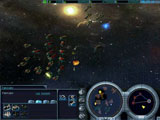 Conquest: Frontier Wars combines an interesting combination of tried and true
RTS features with several significant alterations to the genre trend that hopefully will
result in huge leaps in gaming concepts for future RTS titles. While its actual gameplay
is not particularly groundbreaking, Conquest: Frontier Wars gives us a glimpse of how
things in the RTS field could be.
Conquest: Frontier Wars combines an interesting combination of tried and true
RTS features with several significant alterations to the genre trend that hopefully will
result in huge leaps in gaming concepts for future RTS titles. While its actual gameplay
is not particularly groundbreaking, Conquest: Frontier Wars gives us a glimpse of how
things in the RTS field could be.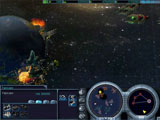 The basic premise of
C:FW is quite simple; Humans, in an effort to expand their territory through the newly
developed technology of wormhole transport, have violently encountered alien races.
Amazingly enough, these races are battling for supremacy of various key sectors of the
galaxy and the wormholes that will permit transport between them. You are placed in
control of forces that can definitively decide the outcome of this conflict. Single player
scenarios allow the player to control the humans, Mantis (insect based alien forms) and
the Celareons (energy based aliens) in battles that span several different sectors and
battlefields. Conquest: Frontier Wars also allows for massive multiplayer conflicts in
addition to a well-developed Quick Battle system that allows the player to work on
skirmishing tactics for use in the multiplayer arena.
The basic premise of
C:FW is quite simple; Humans, in an effort to expand their territory through the newly
developed technology of wormhole transport, have violently encountered alien races.
Amazingly enough, these races are battling for supremacy of various key sectors of the
galaxy and the wormholes that will permit transport between them. You are placed in
control of forces that can definitively decide the outcome of this conflict. Single player
scenarios allow the player to control the humans, Mantis (insect based alien forms) and
the Celareons (energy based aliens) in battles that span several different sectors and
battlefields. Conquest: Frontier Wars also allows for massive multiplayer conflicts in
addition to a well-developed Quick Battle system that allows the player to work on
skirmishing tactics for use in the multiplayer arena.
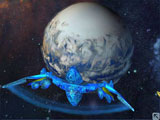 As the overview tends to show, there is not much in terms of the
storyline that seems to be innovative or unusual. Alien races in conflict always seem to
provide for a quick and easy explanation of the purpose for the gaming experience. The
truly interesting adaptation to the traditional RTS building and bashing process is the
introduction of limited building locations, the need to establish lines of supply and the
entire idea of supplying units consistently throughout a scenario--and of course the
wormhole.
As the overview tends to show, there is not much in terms of the
storyline that seems to be innovative or unusual. Alien races in conflict always seem to
provide for a quick and easy explanation of the purpose for the gaming experience. The
truly interesting adaptation to the traditional RTS building and bashing process is the
introduction of limited building locations, the need to establish lines of supply and the
entire idea of supplying units consistently throughout a scenario--and of course the
wormhole.
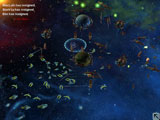 As
an example, Conquest only allows for the creation of buildings and superstructures around
planets due to the fact that these superstructures will require a significant level of
support to operate (Conquest even includes the concept of conscripting crew members,
necessitating the discovery of new places to find recruits). This being the case, players
can’t simply build at will without any thought other than the cost in resources.
Planets are limited in the numbers of superstructures they can support, so players will
have to carefully plan where and when to build structures and whether the benefits of
having that structure actually outweigh the needs of other activities. Also, units do not
carry unlimited amounts of arms and other supplies. Thus, players are required to also
prepare supply ships and leave supply routes open so that units can resupply and continue
to battle. This added level of complexity tends to cut down a bit on the simple build,
horde, and destroy mentality encouraged in so many other RTS type games.
As
an example, Conquest only allows for the creation of buildings and superstructures around
planets due to the fact that these superstructures will require a significant level of
support to operate (Conquest even includes the concept of conscripting crew members,
necessitating the discovery of new places to find recruits). This being the case, players
can’t simply build at will without any thought other than the cost in resources.
Planets are limited in the numbers of superstructures they can support, so players will
have to carefully plan where and when to build structures and whether the benefits of
having that structure actually outweigh the needs of other activities. Also, units do not
carry unlimited amounts of arms and other supplies. Thus, players are required to also
prepare supply ships and leave supply routes open so that units can resupply and continue
to battle. This added level of complexity tends to cut down a bit on the simple build,
horde, and destroy mentality encouraged in so many other RTS type games.
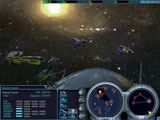 The true key to the game is the presence of the wormhole, which
causes a single scenario to cover three or four different sectors, each with a unique
environment and twist to the development of the battle. Not only is the inclusion of the
wormhole interesting in that it expands the field of conflict and what that field might
appear to be, but it also creates an almost hypertextual feel to the battle. Small points
of conflict can break out in different sectors all at the same time, necessitating a
highly developed battle plan. The AI is programmed not to attack in just one place at a
time or in a recurring and predictable fashion. Rather, the player is forced to react
constantly to new wrinkles in the game. In short, just because you have mastered skills in
TA, Starcraft, or Age of Empires does not mean that they will transfer to Conquest. Be
ready to learn and change.
The true key to the game is the presence of the wormhole, which
causes a single scenario to cover three or four different sectors, each with a unique
environment and twist to the development of the battle. Not only is the inclusion of the
wormhole interesting in that it expands the field of conflict and what that field might
appear to be, but it also creates an almost hypertextual feel to the battle. Small points
of conflict can break out in different sectors all at the same time, necessitating a
highly developed battle plan. The AI is programmed not to attack in just one place at a
time or in a recurring and predictable fashion. Rather, the player is forced to react
constantly to new wrinkles in the game. In short, just because you have mastered skills in
TA, Starcraft, or Age of Empires does not mean that they will transfer to Conquest. Be
ready to learn and change.
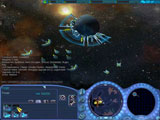 Not everything in Conquest is peachy-keen, however. The graphics
and sounds effects in the game, as was mentioned before, are nothing to get too excited
about. The ships are quite plain and battles are spectacularly unexciting. Weapons on most
craft are so simple they seem to be just dots flying from one ship to another; this is
pretty disappointing in an age where detail is king. Sound effects are similarly
unimpressive and leave me turning off the sound in the game and looking for mp3’s to
establish the mood. The player interface is somewhat simplistic and doesn’t allow for
a lot of adaptability or alteration which can cause a lot of problems, especially when
trying to coordinate armada movements with the speeds of various units and the supply
radius of your ships.
Not everything in Conquest is peachy-keen, however. The graphics
and sounds effects in the game, as was mentioned before, are nothing to get too excited
about. The ships are quite plain and battles are spectacularly unexciting. Weapons on most
craft are so simple they seem to be just dots flying from one ship to another; this is
pretty disappointing in an age where detail is king. Sound effects are similarly
unimpressive and leave me turning off the sound in the game and looking for mp3’s to
establish the mood. The player interface is somewhat simplistic and doesn’t allow for
a lot of adaptability or alteration which can cause a lot of problems, especially when
trying to coordinate armada movements with the speeds of various units and the supply
radius of your ships.
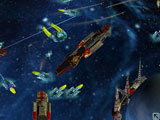 RTS
games have enjoyed a wide spread upswing in popularity in the last few years, with titles
such as Total Annihilation, Command and Conquer, Age of Empires, Warcraft, and Starcraft
all establishing trend setting marks for performance, quality of gaming experience,
narrative development, and overall player enjoyment. However, as is often the situation,
the RTS genre can be said to be suffering from the weakness of success.
RTS
games have enjoyed a wide spread upswing in popularity in the last few years, with titles
such as Total Annihilation, Command and Conquer, Age of Empires, Warcraft, and Starcraft
all establishing trend setting marks for performance, quality of gaming experience,
narrative development, and overall player enjoyment. However, as is often the situation,
the RTS genre can be said to be suffering from the weakness of success.
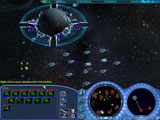 The
problem with success, in any field, is that once a product fills a niche or establishes a
new paradigm, it becomes difficult to work outside the lines of that success. Doing so
normally entails risk, and especially in today’s shaky economic environment, risk is
really not something most companies want to get involved in. This being the case, we can
suddenly understand the rise in the number of sequels, remakes, and general feel of
repetition in the entertainment industry. Cloning has been proven over and over to be a
smart and lucrative business practice; giving the public what they want, even if they have
already had it several times in the past, is a time-honored technique in marketing.
The
problem with success, in any field, is that once a product fills a niche or establishes a
new paradigm, it becomes difficult to work outside the lines of that success. Doing so
normally entails risk, and especially in today’s shaky economic environment, risk is
really not something most companies want to get involved in. This being the case, we can
suddenly understand the rise in the number of sequels, remakes, and general feel of
repetition in the entertainment industry. Cloning has been proven over and over to be a
smart and lucrative business practice; giving the public what they want, even if they have
already had it several times in the past, is a time-honored technique in marketing.
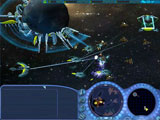 Clones within the RTS field are just as plentiful as the
time-honored veterans they imitate. These games profit from the popularity of their
cousins and also fill the shelves of gaming stores with multiple titles that can offer
subtle alterations in game play that can take advantage of gamer tastes. The problem with
these clones, however, is that they induce a type of creative drought. If clones are
selling well, what is the use of spending time to try and develop new ideas, especially
ones that require exploration if untested realms of the gaming experience? It comes down
to a question of artistic creativity versus economic pressure to sell and develop profits
that will allow future titles to be developed and released.
Clones within the RTS field are just as plentiful as the
time-honored veterans they imitate. These games profit from the popularity of their
cousins and also fill the shelves of gaming stores with multiple titles that can offer
subtle alterations in game play that can take advantage of gamer tastes. The problem with
these clones, however, is that they induce a type of creative drought. If clones are
selling well, what is the use of spending time to try and develop new ideas, especially
ones that require exploration if untested realms of the gaming experience? It comes down
to a question of artistic creativity versus economic pressure to sell and develop profits
that will allow future titles to be developed and released.
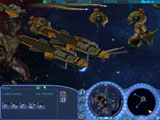 The importance of Conquest is more than just its push into a new
area of RTS gaming where the player controls multiple areas of conflict simultaneously
(which is a long overdue aspect of RTS gaming); it also represents a willingness to think
outside of the box created by previous successes in the field. Wormholes, interactive
environments, and 3D warfare herald a hopeful evolution in the progress of the RTS field
and yet-undreamed-of game play horizons. They allow gamers to play not only newer versions
of old favorites with new gusto, but will also encourage new titles with new concepts to
be created and released in the future. Kudos to UbiSoft for their courageous support of
this title and what it means to us RTS fans!
The importance of Conquest is more than just its push into a new
area of RTS gaming where the player controls multiple areas of conflict simultaneously
(which is a long overdue aspect of RTS gaming); it also represents a willingness to think
outside of the box created by previous successes in the field. Wormholes, interactive
environments, and 3D warfare herald a hopeful evolution in the progress of the RTS field
and yet-undreamed-of game play horizons. They allow gamers to play not only newer versions
of old favorites with new gusto, but will also encourage new titles with new concepts to
be created and released in the future. Kudos to UbiSoft for their courageous support of
this title and what it means to us RTS fans!
